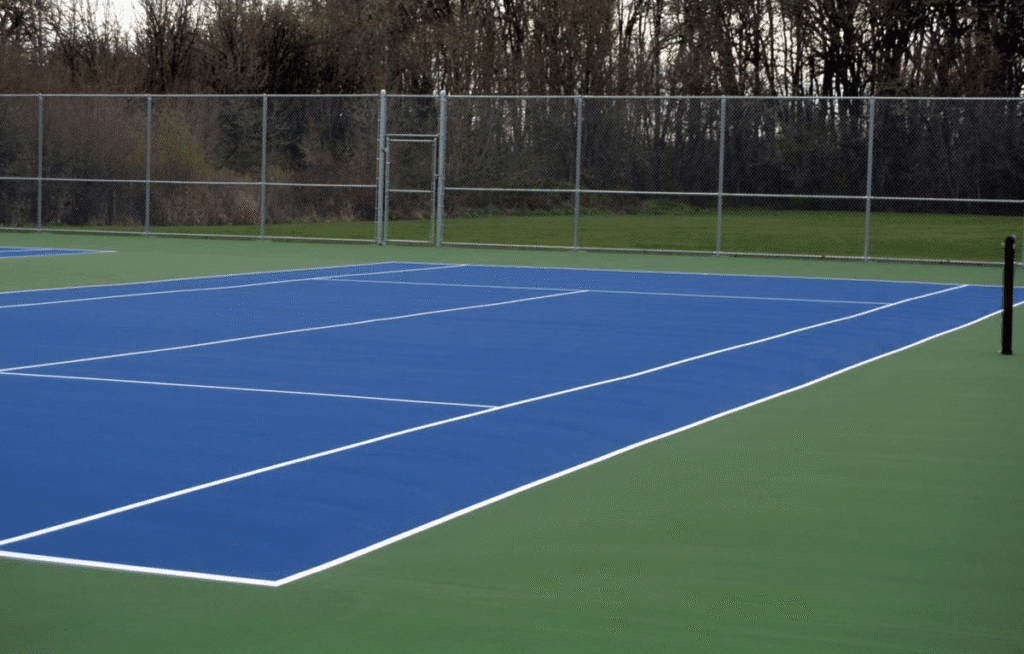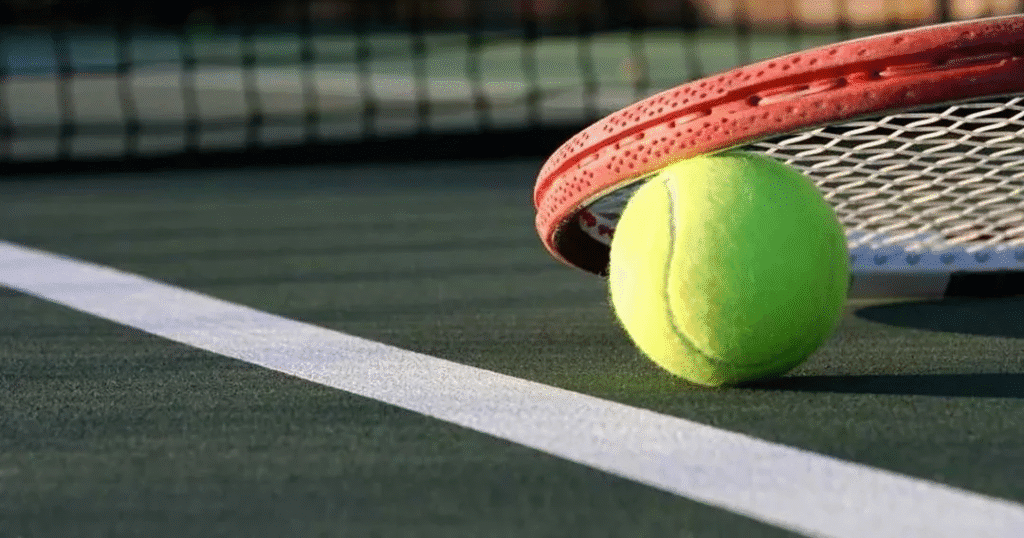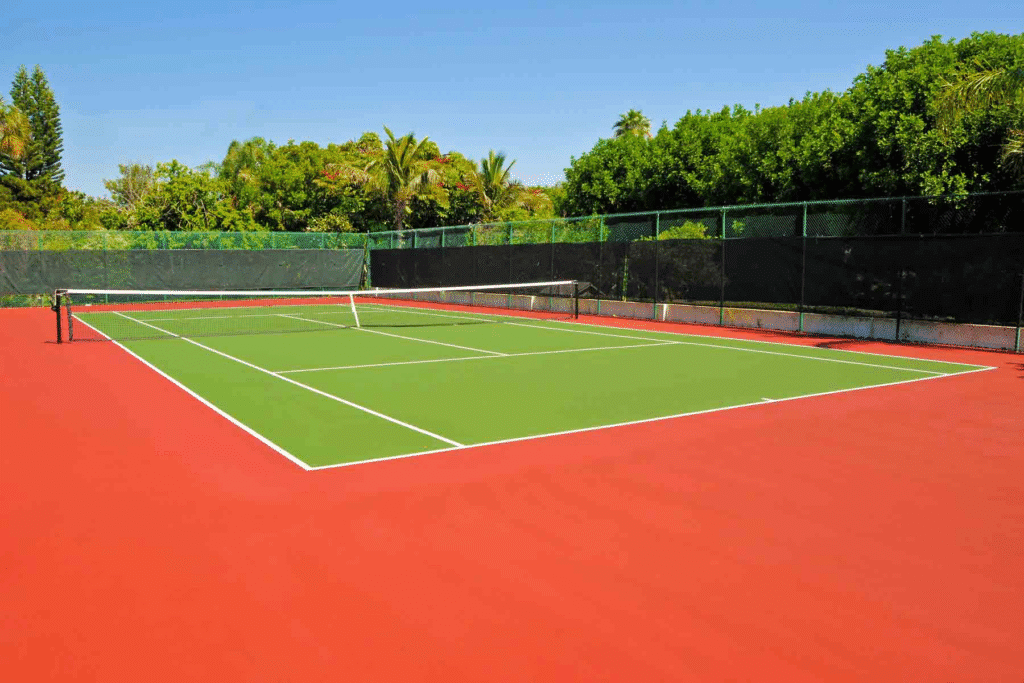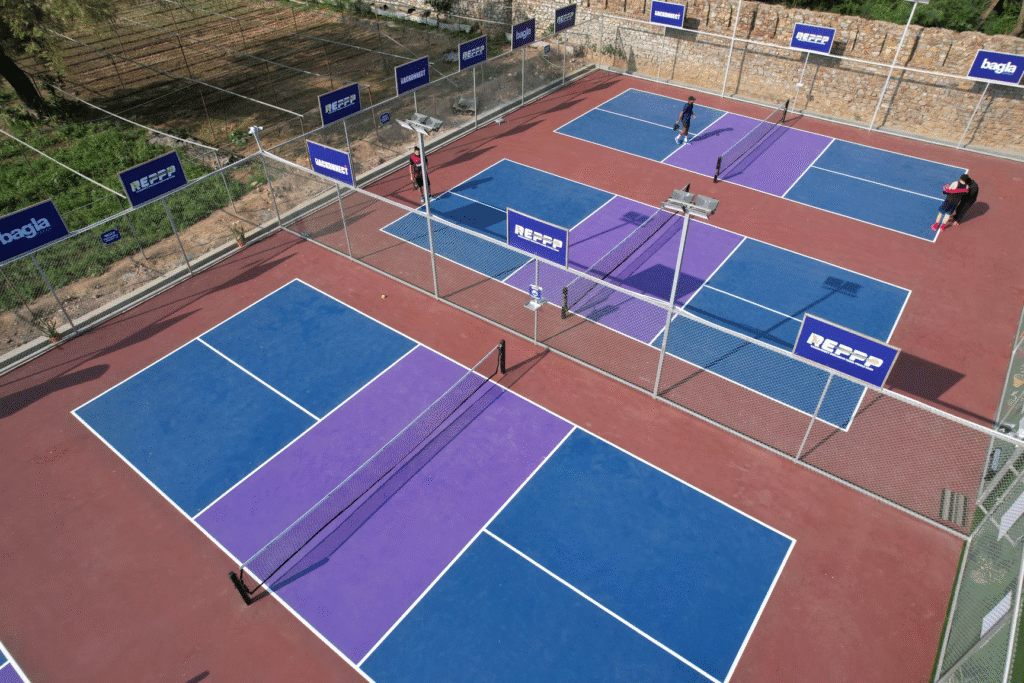Pickleball and tennis are two of the fastest-growing sports, attracting players of all ages. With more people looking to stay active and social, understanding the differences between a pickleball court vs tennis court is essential. These distinctions help players choose the sport that best suits their needs, guide facility owners in making the most of their space, and offer valuable insights for anyone planning to join the action or invest in new courts.
Table of Contents
Dimensions and Layout
When comparing pickleball courts and tennis courts, the most noticeable difference is their size and layout. Let’s break it down:
Pickleball Court Dimensions
- A standard pickleball court measures 20 feet wide by 44 feet long.
- This size is consistent for both singles and doubles play, making it more compact and easier to set up in smaller spaces.
- The net height is 34 inches at the center and 36 inches at the sidelines, slightly lower than a tennis net.
- The court is divided into three main areas: the non-volley zone (commonly called the kitchen), the service areas, and the baseline.
Tennis Court Dimensions
- A standard tennis court is significantly larger, measuring 78 feet long. The width varies:
- 27 feet wide for singles matches.
- 36 feet wide for doubles matches.
- The net height is 36 inches at the center, slightly higher than a pickleball net.
- Tennis courts have more expansive baselines and sidelines, which accommodate the faster pace and longer rallies of the game.
Space Comparison
- A pickleball court is roughly 1/4 the size of a tennis court, making it ideal for smaller spaces or multi-use facilities.
- In fact, you can fit four pickleball courts within the footprint of a single tennis court, which is why many tennis courts are being converted to pickleball courts in shared recreational spaces.
Layout Differences
- Pickleball courts are designed for shorter, more controlled movements, while tennis courts cater to longer sprints and wider angles.
- The smaller size of a pickleball court creates a more intimate and fast-paced game, whereas the larger tennis court allows for more strategic, long-range play.
Surface and Markings

The surface and markings of pickleball and tennis courts play a crucial role in how each game is played. While there are some similarities, the differences are tailored to the unique demands of each sport.
Court Surfaces
Both pickleball and tennis courts can be constructed using similar materials, but the choice of surface can impact gameplay:
- Common Surface Materials:
- Asphalt or Concrete: The most popular surfaces for both sports due to durability and cost-effectiveness.
- Acrylic Coating: Often added to provide a smooth, non-slip finish and vibrant court colors.
- Clay: More common for tennis courts, offering slower ball speeds and softer landings.
- Grass: Rare for pickleball but traditional for tennis, providing a faster game with unique ball bounces.
- Indoor Surfaces: Pickleball courts are often set up indoors on gym floors or multi-purpose surfaces.
- Surface Texture:
- Pickleball courts typically have a smoother surface to accommodate the lighter plastic ball.
- Tennis courts may have more texture to handle the higher speeds and spins of a felt-covered tennis ball.
Court Markings
The markings on each court are distinct and designed to guide gameplay:
- Pickleball Court Markings:
- The court is divided into two equal halves by the net.
- Each half has a non-volley zone (the kitchen), which extends 7 feet from the net on both sides. Players cannot volley the ball while standing in this area.
- Service areas are divided into left and right sections, with clear lines marking the boundaries.
- The lines are typically 2 inches wide and are painted in contrasting colors for visibility.
- Tennis Court Markings:
- Tennis courts have more extensive markings to accommodate singles and doubles play.
- The baseline, service lines, and sidelines define the playing area, with additional markings for the service boxes.
- The lines are also 2 inches wide, but the outer doubles sidelines and center service line are more prominent due to the larger court size.
Multi-Use Courts
- Many facilities are now creating multi-use courts by overlaying pickleball markings on existing tennis courts.
- This is achieved by painting pickleball lines in a different color (e.g., yellow or blue) to distinguish them from the white tennis lines.
- While this is a cost-effective solution, it can sometimes cause confusion for players, especially during fast-paced games.
Impact on Gameplay
- The smaller and more defined markings of a pickleball court create a game that emphasizes precision and control.
- Tennis court markings, on the other hand, allow for a wider range of movement and strategic shot placement.
Equipment and Gameplay Impact

The differences in court size and layout between pickleball and tennis also influence the equipment used and the style of gameplay. Let’s explore how these factors shape each sport.
Equipment Differences
- Paddles vs. Rackets:
- Pickleball: Players use paddles made of lightweight materials like composite, graphite, or wood. These paddles are smaller and more compact than tennis rackets, designed for quick reactions and precise control.
- Tennis: Players use larger rackets with strings, which allow for more power, spin, and reach. The size and weight of tennis rackets make them better suited for the longer rallies and faster ball speeds of tennis.
- Balls:
- Pickleball: The ball is a lightweight, perforated plastic ball (similar to a wiffle ball). It travels slower than a tennis ball and has less bounce, making it ideal for the smaller court and shorter rallies.
- Tennis: The ball is made of rubber and covered with felt, designed to bounce higher and travel faster. The heavier ball requires more force to hit and is better suited for the larger court.
- Net:
- Pickleball: The net is slightly lower, measuring 34 inches at the center. This lower height accommodates the slower ball and encourages a more strategic, finesse-based game.
- Tennis: The net is 36 inches at the center, designed to handle the higher ball speeds and more aggressive play of tennis.
Gameplay Impact
- Court Size and Movement:
- The smaller pickleball court requires less running and favors quick, lateral movements. This makes the game more accessible to players of all ages and fitness levels.
- Tennis courts demand more stamina and agility, as players need to cover a larger area and handle faster-paced rallies.
- Pace of Play:
- Pickleball is generally slower-paced, with an emphasis on strategy, placement, and finesse. The smaller court and lighter ball encourage players to focus on dinks, volleys, and controlled shots.
- Tennis is faster-paced, with longer rallies and more powerful shots. The larger court allows for a wider variety of play styles, from baseline rallies to net play.
- Skill and Strategy:
- In pickleball, the non-volley zone (kitchen) adds a unique strategic element, as players must carefully time their shots and avoid stepping into the zone while volleying.
- Tennis strategy often revolves around power, spin, and court positioning, with players using the larger court to create angles and force their opponents out of position.
Accessibility and Learning Curve
- Pickleball’s smaller court, slower ball, and simpler equipment make it easier for beginners to pick up and enjoy.
- Tennis, while rewarding, has a steeper learning curve due to the larger court, faster ball, and more complex techniques.
Cost and Maintenance

When deciding between pickleball and tennis courts, understanding the costs and maintenance requirements is essential. Both sports have unique needs, and these factors can influence your choice, whether you’re building a court or maintaining an existing one.
Cost of Building a Court
- Pickleball Court:
- A standard pickleball court is smaller, requiring less space and fewer materials, which makes it more cost-effective to build.
- The average cost to construct a pickleball court ranges from $15,000 to $30,000, depending on factors like surface material, fencing, and lighting.
- Multi-court setups (e.g., converting a tennis court into four pickleball courts) can save money by utilizing existing infrastructure.
- Tennis Court:
- Tennis courts are significantly larger, requiring more materials and labor to construct.
- The average cost to build a tennis court ranges from $40,000 to $100,000, depending on the surface type (e.g., asphalt, clay, or grass) and additional features like lighting and seating.
- The larger size and more complex layout contribute to the higher cost.
Maintenance Costs
- Pickleball Court:
- Maintenance is relatively low due to the smaller size and lighter wear and tear from the game.
- Regular upkeep includes cleaning the surface, repainting lines, and ensuring the net is in good condition.
- Annual maintenance costs typically range from $500 to $1,000, depending on usage and surface type.
- Tennis Court:
- Tennis courts require more frequent and intensive maintenance due to their larger size and the impact of heavier equipment and faster gameplay.
- Clay courts need daily grooming, while grass courts require mowing and rolling.
- Hard courts (asphalt or concrete) need resurfacing every 4-8 years, which can cost $4,000 to $10,000.
- Annual maintenance costs can range from $1,000 to $5,000, depending on the surface and level of use.
Durability and Longevity
- Pickleball Court:
- The smaller court size and lighter equipment result in less wear and tear, extending the lifespan of the surface.
- With proper maintenance, a pickleball court can last 10-15 years before requiring major repairs.
- Tennis Court:
- The larger court size and heavier use mean more frequent repairs and resurfacing are needed.
- Hard courts typically last 7-10 years before requiring resurfacing, while clay and grass courts need ongoing care to remain playable.
Shared and Multi-Use Courts
- Converting a tennis court into a multi-use facility with pickleball lines is a cost-effective option for communities and recreational centers.
- Adding pickleball lines to an existing tennis court costs around $500 to $1,000, making it an affordable way to accommodate both sports.
Long-Term Considerations
- Pickleball courts are often more budget-friendly for smaller communities or private homeowners due to their lower construction and maintenance costs.
- Tennis courts, while more expensive, offer a traditional and versatile option for larger facilities and competitive play.
Accessibility and Popularity

The accessibility and popularity of pickleball and tennis have evolved over time, with each sport catering to different audiences and needs. Let’s explore how these factors influence their appeal.
Accessibility
- Pickleball:
- Easier to Learn: Pickleball has a gentler learning curve, making it ideal for beginners. The smaller court, slower ball, and simplified rules allow players to pick up the game quickly.
- Less Physically Demanding: The compact court size and slower pace make pickleball accessible to players of all ages and fitness levels, including seniors and those with limited mobility.
- Lower Equipment Costs: Paddles and balls are relatively inexpensive, with starter sets available for as little as $30-$50.
- Space Requirements: Pickleball courts require less space, making them easier to set up in backyards, community centers, or multi-use facilities.
- Tennis:
- More Physically Demanding: Tennis requires greater stamina, agility, and strength due to the larger court and faster-paced gameplay. This can make it less accessible for beginners or older players.
- Higher Equipment Costs: Tennis rackets and balls are more expensive, with quality rackets starting at $100 or more.
- Space Requirements: Tennis courts require significantly more space, which can be a barrier for smaller communities or private facilities.
Popularity
- Pickleball:
- Rapid Growth: Pickleball is one of the fastest-growing sports in the United States, with participation increasing by over 150% in the last three years. Its social and inclusive nature has made it a favorite among recreational players.
- Community Appeal: The smaller court size and slower pace encourage social interaction, making it a popular choice for community centers, retirement communities, and family gatherings.
- Conversion Trend: Many tennis courts are being converted into pickleball courts to meet the growing demand, especially in urban areas where space is limited.
- Tennis:
- Established Tradition: Tennis has a long history and remains a staple in professional sports, with iconic tournaments like Wimbledon and the US Open drawing global attention.
- Global Reach: Tennis is played and celebrated worldwide, with a strong presence in schools, clubs, and professional circuits.
- Competitive Edge: Tennis appeals to players seeking a more intense, competitive experience, making it a favorite for athletes and sports enthusiasts.
Demographics
- Pickleball:
- Initially popular among older adults, pickleball is now attracting younger players, including families and millennials, due to its fun and accessible nature.
- The sport’s social aspect and shorter game times make it appealing for casual players and those looking for a quick workout.
- Tennis:
- Tennis has a broader age range of participants, from young children learning the basics to professional athletes competing at the highest levels.
- It remains a popular choice for those seeking a more traditional and competitive sport.
Cultural and Social Impact
- Pickleball’s rise in popularity has created a sense of community, with many players forming leagues, hosting tournaments, and enjoying the sport as a social activity.
- Tennis continues to inspire through its rich history, iconic players, and global tournaments, maintaining its status as a prestigious and aspirational sport.
Which Court is Right for You?

Choosing between a pickleball court and a tennis court depends on several factors, including your space, budget, and the preferences of the players. Here’s a guide to help you decide which court is the best fit for your needs.
1. Space Availability
- Pickleball Court:
- Ideal for smaller spaces, as it requires only 20×44 feet.
- You can fit four pickleball courts within the footprint of a single tennis court, making it a great option for maximizing space in community centers or recreational facilities.
- Perfect for backyards or multi-use areas where space is limited.
- Tennis Court:
- Requires a much larger area, with dimensions of 78×36 feet for doubles play.
- Best suited for larger properties, schools, or sports complexes with ample space.
2. Budget
- Pickleball Court:
- More cost-effective to build and maintain, with construction costs ranging from $15,000 to $30,000.
- Lower maintenance costs make it a budget-friendly option for individuals and smaller communities.
- Tennis Court:
- A larger investment, with construction costs ranging from $40,000 to $100,000.
- Higher maintenance costs, especially for clay or grass courts, may be a consideration for long-term upkeep.
3. Player Demographics
- Pickleball Court:
- Perfect for players of all ages and skill levels, especially beginners, seniors, and families.
- The smaller court and slower pace make it accessible and enjoyable for casual and social play.
- Tennis Court:
- Better suited for players seeking a more intense, competitive experience.
- Appeals to athletes and sports enthusiasts who enjoy the physical challenge and strategic depth of tennis.
4. Community Interest
- Pickleball Court:
- If your community has a growing interest in pickleball, building or converting courts can meet the demand and foster social engagement.
- The sport’s rapid growth makes it a popular choice for recreational facilities and retirement communities.
- Tennis Court:
- If your community has a strong tradition of tennis or hosts competitive events, investing in a tennis court may be the better option.
- Tennis courts can also accommodate other sports like badminton or volleyball with minor adjustments.
5. Versatility
- Pickleball Court:
- While primarily designed for pickleball, the smaller court size limits its versatility for other sports.
- However, pickleball courts can be easily added to existing tennis courts for multi-use functionality.
- Tennis Court:
- Tennis courts are more versatile and can be adapted for other sports or activities, such as pickleball (with additional markings), basketball, or even futsal.
6. Long-Term Goals
- Pickleball Court:
- A great option for fostering a sense of community and encouraging social play.
- Ideal for those looking for a low-maintenance, accessible sport that appeals to a wide range of players.
- Tennis Court:
- A better choice for those who value tradition, competitive play, and the prestige of owning or managing a tennis facility.
- Suitable for long-term investments in professional or high-level recreational sports.
Final Thoughts
When deciding between a pickleball court and a tennis court, consider your space, budget, and the needs of your players. If you’re looking for a cost-effective, social, and accessible option, a pickleball court might be the way to go. On the other hand, if you have the space and resources for a larger, more versatile facility, a tennis court could be the perfect fit.
